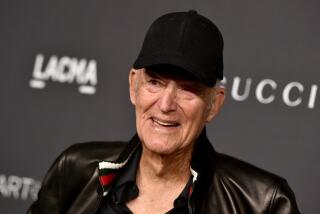Herbert Muschamp; architecture critic for the New York Times
- Share via
Herbert Muschamp, the controversial former New York Times architecture critic whose influential and highly personal commentaries dwelled less on the formal properties of buildings than on their emotional quality, died Tuesday of lung cancer in New York City, the newspaper said. He was 59.
For 12 years ending in 2004, Muschamp was one of the country’s most provocative and analyzed critics, who wrote with an exuberance that became his hallmark.
One of his most quoted reviews was a paean to the Frank Gehry-designed Guggenheim Museum in Bilbao, Spain. Muschamp declared that it was “the reincarnation of Marilyn Monroe” for a voluptuous style that “likes to let its dress fly up in the air.” That review is often credited with turning Gehry into a household name.
His critiques were laden with pop-culture references, sometimes delivered in stream-of-consciousness style. Los Angeles’ Walt Disney Concert Hall, another Gehry creation, reminded him of “Pumpkin into carriage, cabbage into concert hall, bippidi-bobbidi-boo,” while he found in the 80 South Street Tower in New York City a dancing quality that made it feel like it was “all hips. Chicka-boom!”
Critic Michael J. Lewis, writing in Commentary a few years ago, said that Muschamp “viewed the pretensions of deconstruction with bemusement. . . . Faced with pretense and obscurantism, he responded much as Warhol had, with a kind of breezy insouciance.”
For buildings and architects he did not favor, Muschamp’s tone could be harshly dismissive, as in 2003 when he called architect Daniel Libeskind’s design for the redevelopment of New York’s World Trade Center site “astonishingly tasteless” and “demagogic.” Despite Muschamp’s panning, Libeskind ultimately won the design competition.
Muschamp was born in Philadelphia in 1947. As an undergraduate at the University of Pennsylvania, he showed a passion for the arts but dropped out after two years and moved to New York, where he often hung out at Andy Warhol’s studio, the Factory.
In New York, he began to study architecture at the Parsons School of Design and eventually taught architecture there. He also directed its graduate program in architecture and design criticism. By the mid-1980s, he was writing criticism for such publications as Vogue and Art Forum. In 1987, he became the New Republic’s first full-time architecture critic.
In 1992 he succeeded Paul Goldberger as the Times’ architecture critic.
A few years later, in an essay for ArtForum explaining his evolving sensibility as a critic, he wrote of his interest in exposing architecture’s undercurrents. “If I have an agenda,” he wrote, “it is to peek beneath the mantles of authority with which architecture needlessly cloaks itself, and reveal the fishtails and horses’ behinds.”
In later years, he amassed critics who said he was guilty of coveting those mantles of authority for himself. When he invited a group of his favorite architects, including Rem Koolhaas and Richard Meier, to participate in an issue of the New York Times Magazine devoted to the rebuilding of the Ground Zero site, he “decided to step out of the usual critic’s role, and with the Times’ approval, he turned himself into an impresario,” Goldberger wrote in his 2004 book “Up From Zero: Politics, Architecture and the Rebuilding of New York.”
In 2004, Muschamp stepped down from the critic’s chair and became a columnist for the Times Style Magazine, where his sense of felicity remained intact, in pieces that ranged in subject from shopping for neckties in Rome to a study of royal handbags.
He is survived by a sister, Muriel, of Largo, Fla.; and two brothers, Robert of Wenham, Mass., and George, of Gettysburg, Pa.
More to Read
The biggest entertainment stories
Get our big stories about Hollywood, film, television, music, arts, culture and more right in your inbox as soon as they publish.
You may occasionally receive promotional content from the Los Angeles Times.











